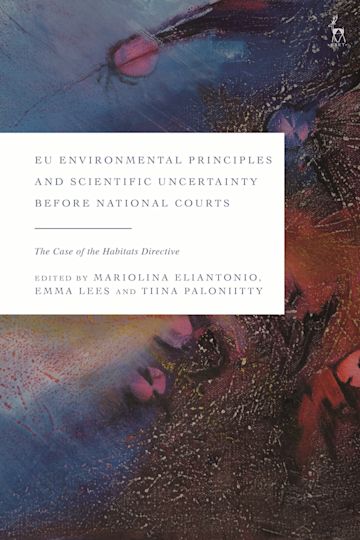Disputes about biodiversity loss involve considerable scientific uncertainty. Uncertainty arises because of the unpredictability and randomness of natural systems and processes. In adjudicating biodiversity-related disputes, courts often need to resolve these issues of uncertainty. How have they done so? This blog post examines this question. It does so by drawing on key findings from my forthcoming book chapter, ‘Biodiversity in the court: the certainty of contests about uncertainty’, in Scientific Uncertainty before National Courts – The Case of the Habitats Directive, co-edited by Mariolina Eliantonio, Emma Lees and Tiina Paloniitty. First, I will discuss the different types of uncertainty: epistemic, methodological or technological, linguistic and sociological. I use the jurisprudence of courts of a particular country, Australia, to illustrate how these uncertainties might arise. Next, I will identify the different stages in biodiversity conservation and the uncertainties that may arise at each stage. Finally, I will conclude by discussing the approaches that Australian courts use to respond to and address uncertainty in biodiversity cases.
Types of uncertainty
Epistemic uncertainty
Epistemic or epistemological uncertainties arise due to inherent variability and natural randomness in ecological systems or processes or the lack of knowledge about ecological systems or processes. They derive from “limitations of measurement devices, insufficient data, extrapolations and interpolations, and variability over time and space” (Helen M Regan et al, ‘A Taxonomy and Treatment of Uncertainty for Ecology and Conservation Biology’ (2002) 12 Ecological Applications 618, 618). These forms of uncertainty often arise in relation to assessing whether a particular endangered ecological community (EEC) is present on a site, as an ecological community is a dynamic entity that is subject to significant variation over time and place. For example, in Commonwealth of Australia v Randwick City Council [2001] NSWLEC 79, epistemic uncertainty affected the determination of the Land and Environment Court of New South Wales (the Court) of whether an EEC, Eastern Suburbs Banksia Scrub, was present on the site. The ecological experts disagreed as to how many of the 46 species listed as characterising the EEC needed to be present. The Court found that the site did not contain sufficient number of the species to qualify as the EEC (at [104]).
Methodological or technological uncertainty
Methodological or technological uncertainty refers to deficiencies in current methods and techniques used to describe natural processes. Methodological uncertainty can arise due to the widespread use of models in environmental regulation. As simplifications of reality, models can only serve to provide approximations rather than truths about the natural world, which means that uncertainty always remains. By giving a false appearance of certainty, models can sometimes magnify or mask uncertainty. In Hornsby Shire Council v Vitone Pty Ltd (2003) 132 LGERA 122, the Court was required to determine the appropriate vegetation survey methodology to be used as there was disagreement between the parties’ experts, each alleging that the other’s methodology generated higher levels of uncertainty. The Court preferred the survey methodology that was more objective.
Sociological uncertainty
Sociological uncertainty arises because technical constructions of scientific logics about environmental risks are not drawn from nature alone, but are socially constructed. They are based on which parameters are considered significant by natural or social scientists. For example, the drawing up of threatened species lists entails social and value-based choices about which species are worth protecting. This is an unequal process. Specific choices are made by the scientific community, governments and the public about which species are worthy of protection. This is often informed by biophilia, which is a form of bias where greater attention and priority is often afforded to larger, more attractive, rare or exotic species (see, Irus Braverman, ‘Chapter 11: En-listing life: red is the color of threatened species lists’ in Kathryn Gillespie & Rosemary-Claire Collard (eds), Critical Animal Geographies: Politics, Intersections and Hierarchies in a Multispecies World (Routledge, 2015) 5, 6, 9-10).
Linguistic uncertainty
Linguistic uncertainty arises because words used in the description and assessment of ecological systems and processes have different or imprecise meanings. Linguistic uncertainty also arises in the laws and policies that regulate the protection of ecological systems and biodiversity, and in how these laws and policies are interpreted. In Corkill v Forestry Commission of New South Wales (No 2) (1991) 73 LGRA 126, the Court was required to determine whether the provisions in the National Parks and Wildlife Act 1974 (NSW), which made it an offence to take or kill any protected or endangered fauna, were concerned only with the direct and intended consequences of killing and taking of animals, or also the indirect consequences caused by disturbance of the habitat of the animals. The Court interpreted these provisions as including both the direct and intended consequences of conduct and the indirect consequences (at 136-137, 139). This decision was upheld by the New South Wales Court of Appeal in Forestry Commission of New South Wales v Corkill (1991) 73 LGRA 247.
Stages in biodiversity conservation where uncertainties occur
In environmental decision-making, a key mechanism for generating information to address knowledge gaps and manage uncertainty is environmental impact assessment (EIA). Knowledge of environmental impacts requires baseline data, which necessitates extensive and continual monitoring and evaluation. However, scientific statements of fact cannot answer the question of what ought to be done in a given situation, which lies at the heart of biodiversity disputes. Consequently, each stage of the EIA process is infused with the choices of the EIA practitioner and the decision-maker that reflect and incorporate societal values and preferences. Uncertainties can occur at almost every stage of EIA decision-making on biodiversity conservation. These stages include:
- The EIA screening process to determine which projects should be subject to EIA requirements: Application of any screening process requires identification of the proposed development, the environment likely to be impacted, and the likely significance of the impacts. Uncertainties can arise in relation to all three. For instance, uncertainty can arise in identifying the nature, extent and other features of the development. In Ballina Shire Council v Palm Lake Works Pty Ltd [2020] NSWLEC 41, there was uncertainty as to whether the proposed development of a seniors housing development involved construction of access roads, water and sewer infrastructure as well as stormwater and vegetation management works in a nearby creek. The Court held that the environmental impacts of all of those works needed to be addressed (at [38]).
- The EIA scoping process to identify the specific environmental issues or concerns to be included in the assessment: Uncertainties may arise in relation to how identified impacts will manifest and the extent of those impacts. The identification of impacts is a predictive exercise based on available ecological evidence, which may be incomplete or inchoate, and the different methods chosen by various experts.
- The preparation of the EIA and assessment of its adequacy: An EIA is an informational tool designed to support and facilitate decision-making under conditions of uncertainty. The relevant environmental legislation will generally prescribe the content requirements for an EIA, including any factors to be considered when preparing it. Epistemic uncertainties will arise in providing this required information. Indeed, the Court in Leatch v Director-General National Parks and Wildlife Service (1993) 81 LGERA 270 recognised epistemic uncertainty as an inherent feature of preparing an impact study due to the dynamism of biodiversity-related phenomena and processes.
- The making of a decision to approve the development: In determining a development application, a decision-maker is under a statutory obligation to consider certain relevant matters, including the impact of the proposed development on the environment. This decision-making exercise is inherently characterised by uncertainty, as the level or degree of environmental assessment, the form in which it must be prepared, and the content of the environmental assessment report will vary depending on the type of development and its environmental impacts.
- The implementation of the project: A step-wise or adaptive management approach can be a useful tool for acknowledging and managing uncertainties over time. This adaptive management approach was followed by the Court in Newcastle & Hunter Valley Speleological Society v Upper Hunter Shire Council & Stoneco Pty Ltd (2010) 210 LGERA 126. This is a pragmatic approach, as it is attuned to the dynamic and changing nature of a development over its life cycle and any contingencies that may arise during its implementation.
Courts’ responses to uncertainties
Courts routinely deal with knowledge limitations and uncertainty in the resolution of the cases before them. My analysis of Australian judicial decisions revealed that Australian courts have mainly encountered and addressed epistemic, linguistic and, occasionally, methodological uncertainties.
Of these, I found that epistemic uncertainty is arguably the most pervasive form of uncertainty in biodiversity decision-making, as it often arises during the listing process for threatened species and EECs, as well as throughout the entire life cycle of the EIA and project approval process. To manage this kind of uncertainty, Australian courts have tended to adopt a pragmatic approach that strongly favours the application of the precautionary principle and other principles of ecologically sustainable development. In some cases, this has led to the refusal of a proposed development where it was found to have likely significant impacts on threatened species or EECs. In other cases, Australian courts have upheld the granting of development consent subject to conditions requiring the adoption of ameliorative measures in line with the precautionary principle, such as monitoring and adaptive management regimes that are attuned to ecological changes over a longer period.
My findings also showed that linguistic uncertainty has arisen as a result of the indeterminate statutory language used in biodiversity conservation. In order to address this type of uncertainty, Australian courts have traditionally favoured a purposive interpretation of legislation, which gives terms their ordinary and natural meaning in a manner that is consistent with and seeks to promote the biodiversity protection objectives of the relevant legislative scheme. Further, the rules of statutory interpretation have also been used to address linguistic uncertainty in legislation that is drafted in ambiguous, vague or indeterminate language.
In sum, my analysis of Australian judicial decisions revealed that Australian courts have generally recognised that uncertainty can be managed and reduced through knowledge production and information gathering processes over time, but not entirely eradicated.
Posted by The Hon. Justice Brian J Preston FRSN SC

Justice Preston is the Chief Judge of the Land and Environment Court of New South Wales. Prior to being appointed in November 2005, he was a senior counsel practising primarily in New South Wales in environmental, planning, administrative and property law. He has lectured in post-graduate environmental law for over 30 years. He is the author of Australia’s first book on environmental litigation and 144 articles, book chapters and reviews on environmental law, administrative and criminal law. He holds numerous editorial positions in environmental law publications and has been involved in a number of international environmental consultancies and capacity-building programs, including for judiciaries throughout Asia, Africa and the European Union.
He is currently a Visiting Professor at Durham University (UK), an Adjunct Professor at the University of Sydney, Western Sydney University and Southern Cross University and former Visiting Fellow at Corpus Christi College and Magdalen College at Oxford University (UK). He is a member of various international environmental law committees and advisory boards, including Chair of the Environmental Law Committee of the Law Association for Asia and the Pacific (LAWASIA) and member of the Governing Board and Vice President for Oceania for the Global Judicial Institute on the Environment (GJIE).
Suggested citation: Justice Preston, “Biodiversity in the court: the certainty of contests about uncertainty”, REALaw.blog available at https://wp.me/pcQ0x2-wx

